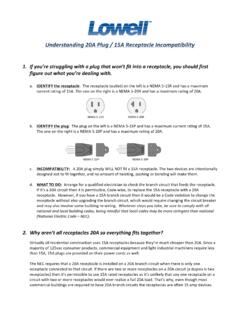Transcription of 25V, 70V, & 100V Constant Voltage Speaker Systems
1 Sheet: GSCREV: 7- 19-17 lowell Manufacturing Company100 Integram DrivePacific, Missouri 63069 : 800-325-9660 Fax: 636-257-6606 Click: , 70V, & 100V Constant Voltage Speaker Systemsby: Joe Ging, Constant Voltage Speaker Systems have been a source of confusion for people for a long time. It s ironic that a system that was specifically designed to make life simpler for designers and installers, still causes so much confusion. In this paper we ll discuss why the Constant Voltage system was created, the advantages of the system, and some basic system design rule-of-thumb guidelines. Once the mystery behind Constant Voltage Speaker Systems has been unlocked, you will probably become a big fan and be able to deal with these Systems quite easily. Understanding the limitations of standard 8 ohm Systems (also called low impedance Systems or voice coil Systems since no matching transformers are used), is an important step toward appreciating the simplicity of Constant Voltage Speaker Systems .
2 8 Ohm Series/Parallel Speaker System WiringThe Golden Rule: For any amplifier, it s important that the impedance of the Speaker load always be equal to or greater than the rated output impedance of the amplifier. For example, it is safe for the amplifier if the 8 output is used to drive an 8 Speaker load or a 16 Speaker load, and it is safe for the 4 output of an amplifier to drive a 4 load, 8 load, or 16 load. As long as the Speaker load impedance is greater than the rated output impedance of the amplifier, the amplifier is safe. It is not safe for the 8 output of an amplifier to drive a 4 load and it is not safe for the 4 output of an amplifier to drive a 2 load. Overloading the output of the amplifier can blow a fuse, trip a circuit breaker, cause audible distortion, and also can damage the amplifier. Ohms Law can be used to determine the impedance of a Speaker load using the formulas in Parallel:ZIN = Z1 + Z2 + Z3.
3 1111 ZIN = NZIdentical ImpedanceSpeakers in Parallel:Where Z = Impedance of One Speaker and N = Number of Speakers In Parallel Note: Z is the formula symbol for in Series:ZIN = Z1 + Z2 + Z3 ..Example: ZIN = 8 + 4 + 8 + 4 = 24 Ohm Load 8 +-4 +-8 +-4 +-ZIN8 +-4 +-8 +-4 +-ZINE xample: ZIN = 8 + 4 + 8 + 4 11111 ZIN = 1. 333 Ohm Load 8 +-8 +-8 +-8 +-ZINE xample: ZIN = 4 Speakers = 2 Ohm Load8 Sheet: GSCREV: 7- 19-17 lowell Manufacturing Company100 Integram DrivePacific, Missouri 63069 : 800-325-9660 Fax: 636-257-6606 Click: s important to understand that the maximum transfer of power from the amplifier to the speakers happens when the Speaker load impedance exactly equals the amplifier output impedance. For example, if an 8 amplifier feeds an 8 Speaker , the total available output from the amplifier will be delivered to the Speaker . If, however, the amplifier with an 8 output feeds a 16 Speaker , not all of the amplifiers available power can be drawn by the 16 Speaker because of the impedance mismatch.
4 Combinations of series and parallel speakers should be combined to match the amplifier output impedance as closely as possible. Take for example where four 8 speakers are to be fed by an amplifier with an 8 output. You can t wire those speakers in parallel because that would result in a 2 load which is too low for the amplifier. If, however, you wire 2 pairs of speakers in series (so each pair would have an impedance of 16 ) and then wired those two series pairs in parallel, the resulting Speaker load would be 8 and that would be a perfect match for the 8 output of the amplifier. Result:One speakerreceives thetotal amplifier :Each speakerreceives of the total amplifier 4 70V25 VCOMR esult:Each speakerreceives of thetotal amplifier 4 70V25 VCOMR esult:Each speakerreceives 1/8 of thetotal amplifier 4 70V25 VCOMOne 8 SpeakerTwo 8 Speakerswired in ParallelFour 8 Speakerswired inSeries/ParallelEight 8 Speakerswired inSeries/ParallelThree 8 Speakers wired in SeriesSP EAK ER+_8 SP EAK ER+_8 SP EAK ER+_8 SP EAK ER+_8 SP EAK ER+_8 SP EAK ER+_8 SP EAK ER+_8 SP EAK ER+_8 SP EAK ER+_8 SP EAK ER+_8 SP EAK ER+_8 SP EAK ER+_8 SP EAK ER+_8 AMPLIFIEROUTPUT8 4 70V25 VCOMSP EAK ER+_8 SP EAK ER+_8 8 Ohm Series/Parallel Speaker System Wiring Examples (Note that polarity is important.)
5 AMPLIFIEROUTPUT8 4 70V25 VCOMR esult: Total amplifier power is reduced due to impedance mismatch. Each Speaker receives 1/3 ofthe reduced total amplifier EAK ER+_8 SP EAK ER+_8 SP EAK ER+_8 Sheet: GSCREV: 7- 19-17 lowell Manufacturing Company100 Integram DrivePacific, Missouri 63069 : 800-325-9660 Fax: 636-257-6606 Click: of 4 speakers can usually be wired in series/parallel to result in a desirable load impedance, but not all Speaker Systems in the real world have multiples of 4 speakers. For example, what if you had five speakers? There s no way possible to wire five speakers in series/parallel so that all speakers would receive the same power and the impedance would match the amplifier output impedance. What if you have 37 speakers? Same problem. What if you had an office complex with 537 speakers. There is no practical way to wire those speakers in series/parallel to properly load the amplifier and make sure that all speakers receive the same power.
6 There are many technical disadvantages to wiring Speaker Systems in series/parallel, but the main disadvantage is the complexity of the wiring scheme required when you are faced with a system with many speakers, or an odd numbers of speakers. This is one of the main reasons why Constant Voltage Speaker Systems were created. Constant Voltage System WiringIt s obvious from the examples just discussed that the ideal Speaker system would be designed so that all speakers can be wired in parallel, no matter how many speakers are included in the system. Constant Voltage Systems use small inexpensive matching transformers (see the lowell R1810-72 to the right) to artificially boost the impedance of an 8 Speaker to a much higher impedance. Considering the impedance formulas discussed on page 1, that means that very many speakers can be wired in parallel because the high impedance of the matching transformers results in a load at the output of the amplifier that is still at a reasonable impedance.
7 See the typical 70V Speaker system wiring below. Constant Voltage Many people get confused by the terminology Constant Voltage . Some wonder how the output of the amplifier can stay at The answer is, the amplifier output Voltage is only at V when it is at full output. Normally a 70V amplifier is turned down some so the output Voltage is less than 70V. The maximum output Voltage of a normal 8 amplifier is different depending on the power rating of the amplifier. All 70V amplifiers, however, have a maximum Voltage output level, whether they are 10 watt amplifiers, or 1000 watt amplifiers. That s where the Constant Voltage term comes from. That is a handy part of the Constant Voltage system design. If a system has a 100 watt 70V amplifier and more speakers are added so the load is greater than 100 watts, the next larger amplifier (maybe a 70V 150W amplifier) can be used to replace the 100W amplifier.
8 No wiring changes to the Speaker circuits are required. No changes to the power taps on the Speaker transformers are required. The key is that the maximum output Voltage is volts regardless of the power capability of the amplifier . WCOMAMPLIFIER70 VCOMTo MoreSpeakersSP EAK ER+-8 SP EAK ER+-8 SP EAK ER+-8 lowell R1810-72 Note that observing wiring polarity is important so that all speakers are operating in : GSCREV: 7- 19-17 lowell Manufacturing Company100 Integram DrivePacific, Missouri 63069 : 800-325-9660 Fax: 636-257-6606 Click: Other Constant Voltage System Advantages:The ease of parallel wiring is not the only advantage of Constant Voltage Speaker Systems . For the remainder of this paper we will put the discussion of 100V Speaker Systems on the back burner. Some lowell Speaker Systems have ratings for 25V, 70V, and 100V operation. The 100V settings are included because those Speaker products are marketed outside of the United States.
9 In the US, is the highest Voltage Speaker system where Class 2 wiring can be used without conduit. In the United States, if a 100V Speaker system is installed in a commercial building, Class 1 Speaker wiring must used and it must be installed in conduit. That makes the sound system installation very expensive, so for all practical purposes, 100V Speaker Systems are used overseas and are typically not installed in the United States. An exception to that rule could be when high powered speakers are installed with very long Speaker lines. As long as the Class 1 wiring and conduit costs can be justified, 100V Systems can be installed in the United States, but that does not happen very often. That application is so rare for our target audience in the US, we are going to concentrate mostly on 25V and 70V Speaker Systems for the remainder of this , 70V, and 100V Constant Voltage Speaker Systems are available.
10 A few clarifications will simplify our discussion as we move forward with this paper. First of all, you may have already noticed that the terms 70V and have been used interchangeably. The correct Voltage level is , so for all calculations, will be used. was chosen by the system designers simply to make the calculations easier. Typing is cumbersome, so very often 70V is used as an abreviation. Keep in mind though, that is the actual Voltage value used. 25V, 70V, & 100V Systems :Longer Speaker Lines or Smaller Gauge Speaker Lines:The reduced cable loss that results from higher amplifier voltages in Constant Voltage Speaker Systems , allows the designer the option to run Speaker lines farther, or to use smaller gauge cable to reduce the cost of the Speaker system installation. Smaller gauge cable has a higher impedance so the loss is higher, but that loss is offset by the higher Voltage of the Power Loss:Any time current flows in a conductor, there is heat loss due to the impedance of the conductors.











